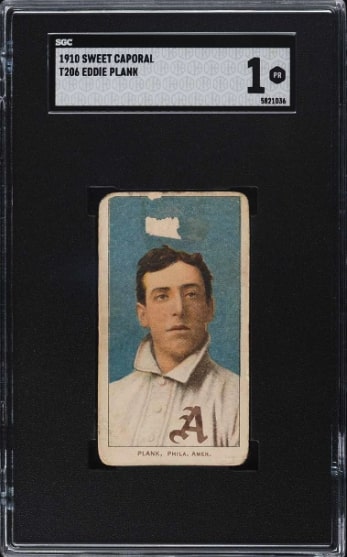
PWCC’s Auction Guide for this Iconic Card
Only one decade after the Civil War ended, a baseball player was born in the same town where President Abraham Lincoln delivered the Gettysburg Address. Two score and ten years later, that American icon of the baseball diamond would die a stone’s throw from that hallowed ground.
When the American Tobacco Company printed this 1909-11 T206 “Gettysburg Eddie” Plank rarity, the Philadelphia Athletics pitching sensation was leaving hitters feeling battered. For nearly two decades, Plank established himself as one of the best left-handed pitchers in the game. When his storied career ended in 1917, no lefty had more wins (326), even though his team frequently suffered from an inability to score runs in its biggest games. His 2.35 career ERA included a 1.76 ERA season in 1909. But when his team needed him the most, he performed the best, recording a paper-thin 1.32 ERA in 54 2/3 World Series innings on his way to helping the Athletics capture three titles. Only Christy Mathewson, Sandy Koufax, and Mariano Rivera have a lower postseason ERA in 50 innings or more.
Read the full guide to the 1909-11 T206 Eddie Plank Card at PWCC Marketplace.

Search for the 1909-11 Eddie Plank trading card in the PWCC Marketplace
If Eddie Plank’s only T206 card did not suffer from scarcity, it would likely still be extremely valuable, given his career accomplishments. But as the star in one of the baseball card industry’s enduring mysteries, the T206 Plank is in short supply. Speculation over the reason why includes theories about his disdain for cigarettes, a broken printing plate, and simple error, but none of these tales show any definite evidence to support the claims.
Regardless of the reason for its low pop count, an apples-to-apples comparison offers perspective on the scarcity of Plank’s T206 card. At the end of 2023, PSA had only graded 21 examples of this Plank issue with a Sweet Caporal ad from the 350 Series distributed out of Factory 30. In contrast, PSA has graded 183 examples of Ty Cobb’s T206 Red Portrait 350/30 card—a whopping 9x as many cards. And Cobb has four front-of-the-card variations in the T206 set, whereas Plank only has one card. It does not hurt that Plank’s T206 card is a stunning rendition of the hurler, with his regal pose, flipped collar, and prominent A’s jersey laid over a soft sky-blue background.
In 1909, the Gettysburg Times expressed their pride in their local kid who made it to the big leagues, describing him as “the Adams County boy who has made the name Gettysburg famous in base ball [sic] circles.” The Times took special pleasure in an August 10, 1909, outing in which Plank pitched a masterpiece and simultaneously cracked a home run. “Edward Plank caused staid men to ruthless destroy their headgear and pound vigorously on the anatomy of their nextdoor neighbor. It was a sight which will never fade from the memories of the 19,080 to see that sphere go bounding gracefully over the head of Killifer [sic], the Detroit center fielder, while Eddie ran around the paths and finally crossed the plate with a home run to his credit. Even the women and girls—and there were hundreds of them there—forgot propriety and screamed and danced as if crazed.”
Not long after, on February 25, 1926, those fans and his hometown newspaper, the Gettysburg Times, gathered again, this time in a state of shock for a different reason. Eddie Plank died a day earlier of a massive stroke. He was 50 years old. “Eddie Plank is Dead” headlined newspapers across the country. As the news flashed across the continent’s wires, the baseball world fell into a depression. Not Eddie. By all accounts, the grief exceeded that which the country felt when Christy Mathewson died because they knew his end was coming. Not Eddie.
The Gettysburg Times bid farewell to its hometown hurler: “Baseball’s greatest southpaw moundsman is dead. He struck out on one pitch of mortal man’s most vicious opponent: Death. A stroke of paralysis that maimed his left side and crippled his mighty left arm proved fatal early Wednesday afternoon. There was no comeback.”
Babe Ruth started pitching for the Red Sox in 1914 when Plank was still pitching for the Athletics. On August 26, 1926, Ruth wrote a memorial letter for Plank, published in newspapers nationwide. “A lot of the present-day players didn’t know Eddie. They never had a chance to play against him. And they don’t know what a great pitcher he was, or what a great part he played in baseball. Some of us who are older in the league did know him, however, and will never forget him,” Ruth wrote.
Ruth added, “Personally, I think Eddie Plank was one of the best pitchers who ever stepped into the box. … Eddie Plank was the real ‘daddy’ of the brainy players. I’ve seen him strike out heavy hitters with pitched balls that didn’t have a thing on ‘em.” Ruth recalled the time Ty Cobb told a reporter Plank was “one of the greatest pitchers in all baseball” and expressed that Plank continues to influence new pitchers with the imprint he left on the game.
Eddie Plank spent his final days as a battlefield tour guide at Gettysburg National Park. He got his own monument in 1946 when the Baseball Hall of Fame posthumously inducted him. Given his impact on the game and how rare it was for someone with his talent to occupy a mound, it is only fitting that his T206 card is known as “the rarity.” Eddie Plank is dead, but his legacy and his cards live on.
Read the full guide to the 1909-11 T206 Eddie Plank Card at PWCC Marketplace.